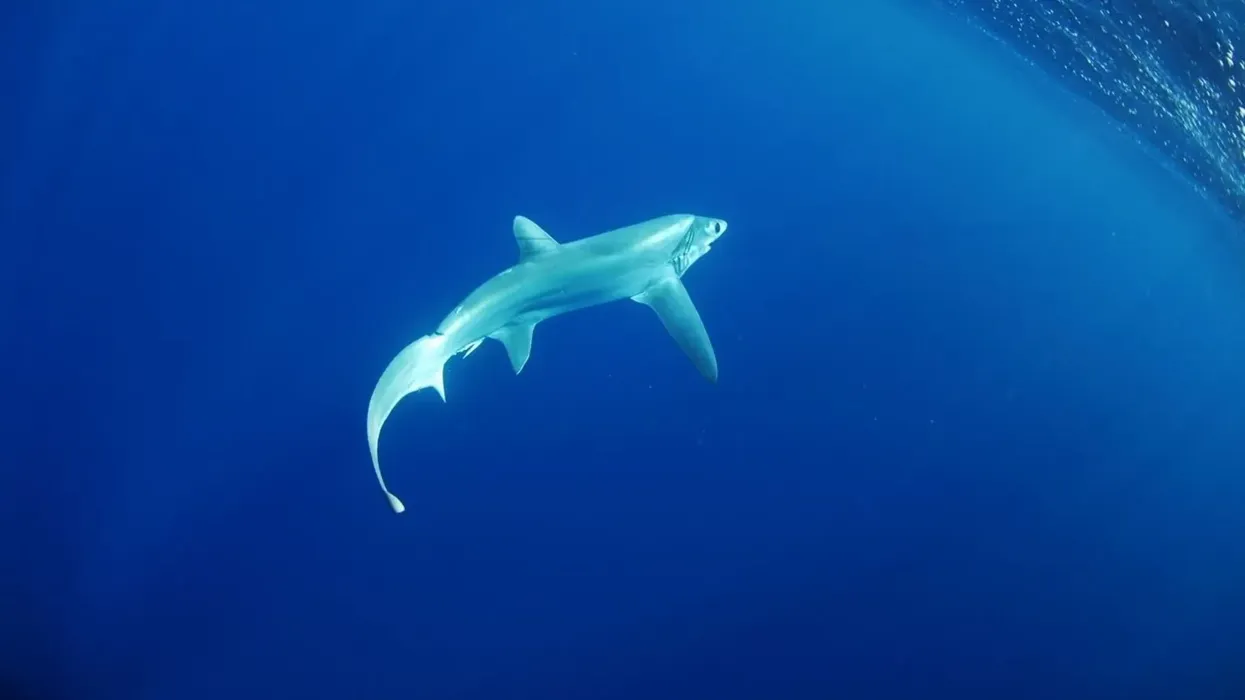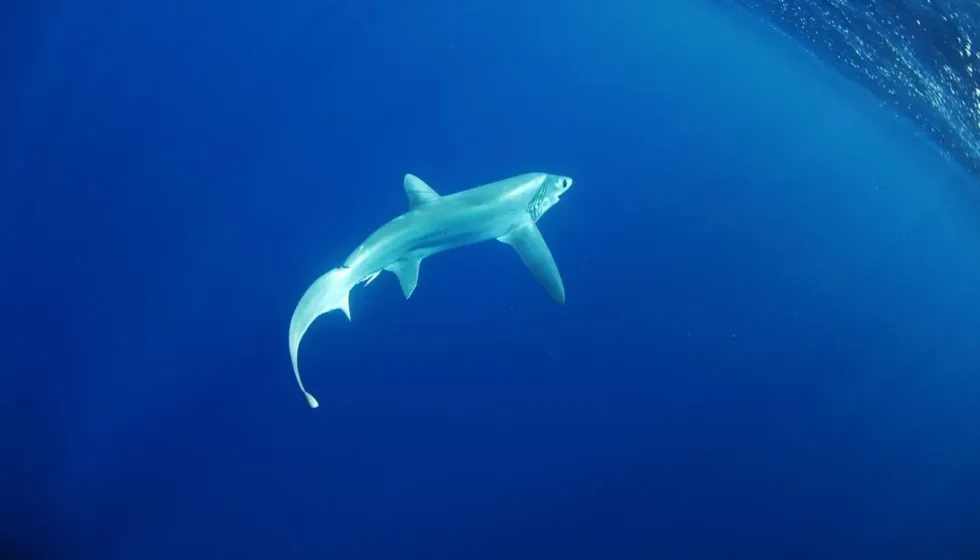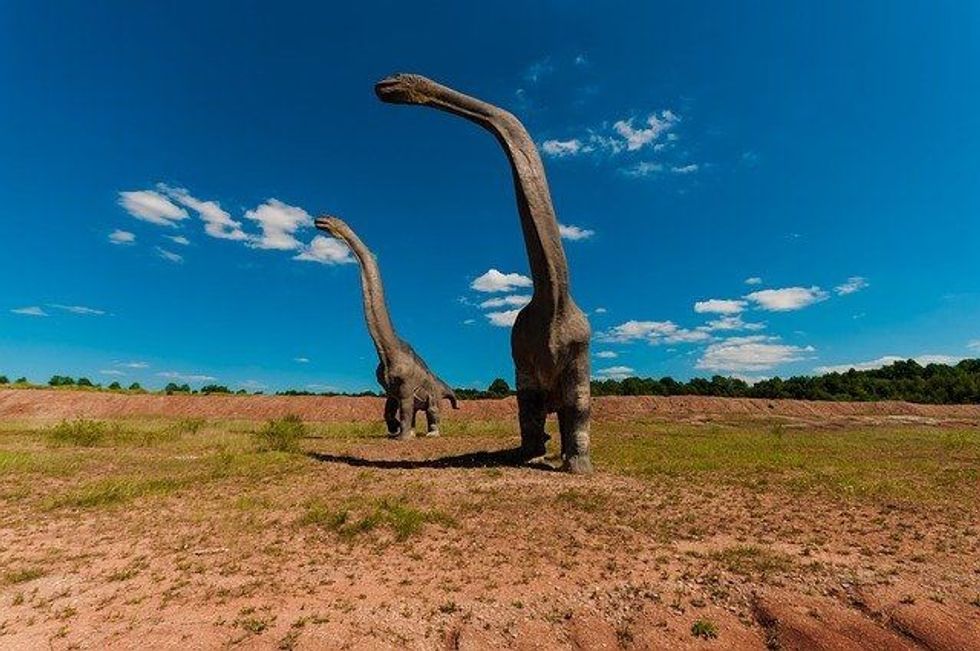Bigeye threshers (Alopias superciliosus) are members of the family Alopiidae similar to Pelagic thresher and are found in the habitat of tropical and temperate oceanic and coastal waters worldwide. It includes three species: Vulpinus, Pelagicus, and Superciliocus.
Bigeye threshers have a big head, and large eyes that are adapted to hunting under low light conditions, and its large upper lobe of the upper caudal tail fin accounts for nearly half its length. Juveniles have large heads than the adults.
Among only a few sharks, it migrates both day and night, spending the day in deep water and feeding at night in surface water. It uses its long tail fin to stun the prey.
Usually, bigeye thresher species bear two pups per litter; they are ovoviviparous. Within the uterus, the embryos feed on ova produced by their mothers. Commercial fisheries catch this shark throughout its range, the meat is not very coveted, but the fins for shark fin soup, skin, liver oil, and scales are highly regarded.
Males mature earlier than females. Globally, it is considered Vulnerable by the International Union for Conservation of Nature (IUCN).
The population status is also unknown. Their life expectancy is 20-21 years.
If you like reading about the bigeye thresher shark, you might also like the zebra shark and the porbeagle shark.
Bigeye Thresher Interesting Facts
What type of animal is a bigeye thresher?
The bigeye thresher shark (Alopias superciliosus) is a thresher shark species from the Alopiidae family.
What class of animal does the bigeye thresher belong to?
It is a type of shark of genus Alopias. The bigeye thresher is closely related to the pelagic thresher (A. pelagicus), with which it forms a clade.
How many bigeye threshers are there in the world?
The exact estimation of the population range is unknown.
Where does the bigeye thresher live?
A bigeye thresher(Alopias superciliosus) distribution is widespread everywhere in the tropics. There have been reports of it from New York to Florida and southern Brazil in the western Atlantic Ocean.
This species is found in the eastern Atlantic from Portugal to Madeira to Senegal to Guinea and even in the Mediterranean Sea. Waters surrounding South Africa, Madagascar, and the Arabian Sea make up a large portion of the western Indian Ocean.
What is a bigeye thresher habitat?
The bigeye thresher shark habitat is typically found in deep coastal marine waters and on the continental shelf, though it can be found on the open sea as well. They are found on open ocean surfaces. They prefer tropical and temperate oceans.
Who does the bigeye thresher live with?
Thresher sharks are solitary creatures that keep to themselves. There is known to be a sex difference in the thresher populations of the Indian Ocean based on the depth and size of the marine water. In spite of their solitary nature, some species hunt as a group of two or three occasions.
How long does a bigeye thresher live?
The life expectancy of bigeye thresher sharks is 20-21 years.
How do they reproduce?
The bigeye thresher shark (Alopias superciliosus) bears litters of two pups, one in each uterus, like other mackerel sharks. Females are usually pregnant throughout the year, and there is no defined breeding season.
There is no known gestation period. As a growing fetus utilizes a yolk sac for nutrition, then later exhibits oophagy when it consumes infertile eggs from their mother.
Unborn embryos have proportionately large heads and eyes than adult sharks. As young, they are approximate of length 4.4-6 ft (1.3-1.8 m). The female lives up to 20 years and the male up to 19 years.
Female bigeye threshers typically produce fewer than 20 eggs over their lifetime. Males mature at 9-10 years of age, and females mature at 12-14 years of age at half their total body length.
What is their conservation status?
The bigeye thresher shark is listed as Vulnerable under the IUCN Red List of endangered species. The population status is unknown. In spite of its low life expectancy, the bigeye thresher species is highly susceptible to overexploitation. They are usually caught for commercial fisheries.
Bigeye Thresher Fun Facts
What does the bigeye thresher look like?
As an adult, bigeye thresher shark's eyes are up to 3.9 in (10 cm) wide. There is a bulbous upper portion to each eye, making it taller than wide.
The head has multiple orbits, which allow the eyes to look upward because they are on the dorsal surface. Additionally, the body is covered in distinctive lateral grooves that extend from above the eyes to over the gill slits, offering a helmet-like appearance.
There is a point at the end of the smaller denticles. Upper lobe of the long upper caudal fin comprises nearly half the body length.
The pectoral fins have broad tips and a curved anterior margin. With the free rear tip above or just before the pelvic fins, the first dorsal fin is placed further back than in other thresher sharks. This tree's leaves are deep violet to purplish-brown on top and creamy white on the bottom.
A dull gray color rapidly replaces this color after death. The average bigeye thresher's total length is 11-13 ft (335.3-396.2 cm) and weighs 350 lb (158.7 kg).
Bigeye threshers are the largest fish ever found in New Zealand. The largest of this species was measured at 4.9 m (16 ft).
Longtails are likely used as a means to stun prey. Their life expectancy is 20-21 years.

*We've been unable to source an image of a bigeye thresher shark. If you are able to provide us with a royalty-free image of a bigeye thresher shark, we would be happy to credit you. Please contact us at hello@kidadl.com
How cute are they?
The bigeye thresher sharks are very cute to look at. The long tails of these sharks make them less scary than other sharks.
How do they communicate?
Because the bigeye thresher sharks live in solitary groups, little is understood about how they communicate. Prey detection behavior is often reliant on other senses since this species has poor vision.
Similar to other sharks, this species rely on their lateral lines to detect vibrations in the surrounding waters. As vibrations travel well in marine water, this makes it easier to locate prey from great distances.
Often threshers have a behavior of sniffing a potential meal or take a small sample bite to determine whether it is edible before going full throttle.
As well as using electromagnetic senses, common thresher Sharks hunt on aquatic prey. Sensing impulses in the marine water from injured and dying fish is possible thanks to sensory organs located in their noses and heads.
How big is the bigeye thresher?
The bigeye thresher length is 11-13 ft (335.3-396.2 cm). It is 2 times bigger than the total length of the bigeye trevally.
How fast can a bigeye thresher swim?
The swimming speed is about 30 mph (48.3 kph) for bigeye thresher sharks species. Its tails can be whipped at an unbelievable speed of 80 mph (128.7 kph) while swimming. This shark catches its prey in a quick, violent manner.
How much does a bigeye thresher weigh?
The bigeye thresher sharks weigh 440 lb (200 kg).
What are the male and female names of the species?
There are no specific names for the separate sexes of the bigeye thresher sharks. They are simply referred to as the female bigeye thresher and the male bigeye thresher. It includes three species: Vulpinus, Pelagicus, and Superciliocus.
What would you call a baby bigeye thresher?
A baby bigeye thresher species is called a pup.
What do they eat?
This thresher species has large teeth, and they feed on a wide variety of prey. Fishes such as mackerel and herring, whiting, lancetfish, and possibly crab have known food items.
The species also consume large forage fish such as lancetfish and billfish. Long-tail are likely used as a means to stun prey before they are captured since many are caught on longlines and with baitfish in their stomachs.
Are they dangerous?
The bigeye thresher shark species do not pose any physical threat to humans since it stays far away from the environment areas where humans swim. Commercial fisheries, however, suffer damage when they are caught in drift nets, as they destroy nets and other equipment.
Would they make a good pet?
No, this species is not allowed to be kept as pets. Fishing recreationally for Atlantic common thresher sharks in federal waters requires an Atlantic HMS permit. Anyone who wants to fish for, keep, possess, or land a shark will need a shark endorsement.
Did you know...
Conflicting evidence exists regarding whether the bigeye thresher is warm-bodied like the common thresher species. Researchers discovered that the bigeye thresher species contains the aerobic red muscles responsible for generating heat, however, they are located on both sides of the body at the flanks, as opposed to near the center.
They are caught for commercial fisheries, and the skin is used to make leather products, the liver oil for vitamins, and the fins for shark fin soup.
Why is it called a bigeye thresher shark?
In reference to the distinct lateral grooves above the eyes, superciliosus is named after the Latin super, meaning above, and ciliosus, meaning brow. Its common name comes from the immense eyes that are placed in keyhole-shaped sockets that enable them to be rotated upward. It includes three species: Vulpinus, Pelagicus, and Superciliocus.
What is so unusual about the thresher shark?
The bigeye thresher can see prey silhouettes even in low light because of its large eyes and upward-oriented posture. They conduct a daily vertical migration, spending the daytime below the thermocline, and ascending above it during the night to shallow water. The bigeye thresher depth is below 330 ft (100 m).
Here at Kidadl, we have carefully created lots of interesting family-friendly animal facts for everyone to discover! For more relatable content, check out these thresher shark facts and reef shark facts.
You can even occupy yourself at home by coloring in one of our free printable bigeye thresher coloring pages.
Second image by Mark Conlin.









